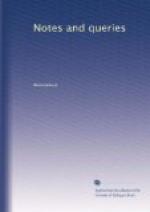wreath’)—’Implentur veteris
Bacchi pinguisque ferinae Anno Dom 1655.’ 10.
The Arms of the late Earl of Yarmouth. 11. The
Arms of the Duke of Norfolk. 12. Neptune on a
Dolphin. 13. A Lion supporting the Arms of Norwich.
14. Charon carrying a reputed Witch to Hell. 15.
Cerberus. 16. An Huntsman. 17. Actaeon [with
three dogs, and this legend, ’Actaeon ego sum
Dominum cognoscite vestrum’]. 18. A White
Hart couchant [underneath appears in the engraving
the artist’s name—Johannes Fairchild
struxit]. 19. Prudence. 20. Fortitude. 21.
Temperance. 22. Justice. 23. Diana [with
two greyhounds, one of whom is chasing a hare]. 24.
Time devouring an Infant [with the legend, ‘Tempus
edax rerum,’ below]. 25. An Astronomer,
who is seated on a Circumferenter, and by some Chymical
Preparation is so Affected that in the fine Weather
he faces that Quarter from whence it is about to come.”
The whole sign is drawn by a scale of half an inch
to a food, and most of the figures are of the size
of life. On both sides of the engraving, but distinct
from the sign, are seven coats of arms. Those
on the right hand are: 1. Earl of Yarmouth.
2. Cornwallis impaling 1st and 4th Buckton, 2nd
Unknown, 3rd Teye. 3. Castleton. 4. Unknown.
5. Mrs. Peck [these arms are wrongly blazoned
by Blomefield; they are
gules a fesse
argent,
between, in chief, two crescents, and in base, a lion
passant guardant of the same]. 6. Great
Yarmouth. 7. Unknown. The arms on the opposite
side are: 1. Duke of Norfolk. 2. Hobart.
3. Bacon. 4. Thurston. 5. Mr. Peck impaling
his wife [his arms, too, are wrongly blazoned; they
should be—Or, on a chevron engrailed gules
three crosslets pattee argent]. 6. Lindley. 7.
Norwich.
Mr. Cooper will find a slight notice of this sign,
both in Gough’s Camden and in The
Beauties of England and Wales; but both these are
of later date than Mr. Cruttwell’s Tour.
I have only to add, that I should wish Mr. Cooper
to see the engraving. I shall be very happy
to send it by post for his inspection.
CRANMORE.
* * * *
*
Parkership, Porkership, Pokership.—With
every deference to the ingenious suggestions of Mr.
Bolton Corney (No. 15. p. 218.), I think it will be
found, on reference to the original documents, that
“Pokership” is a misreading of the ancient
writing for “Parkership.” This question
might be determined if any correspondent, acquainted
with the present excellent arrangement of our records,
could inform us whether the appointments under the
old Earldom of March are extant. A large portion
of Herefordshire was held under his tenure. Thomas
Croft, of Croft, was, in 1473, “Parker”
of Pembrugge, in that county: Rot. Parl.
vi. 342. In 1485 John Amyas {324} was, by the
act of settlement made on the accession of Henry VII.,
continued in his office “of the kepyng of our
chase of Moketree in Wigmoresland under the Erledom
of Marche,” and Thomas Grove “in the keepying
of our chase of the Boryngwood in Wigmoresland and
of the ‘Poulterership’ and keping of the
ditch of the same.”




